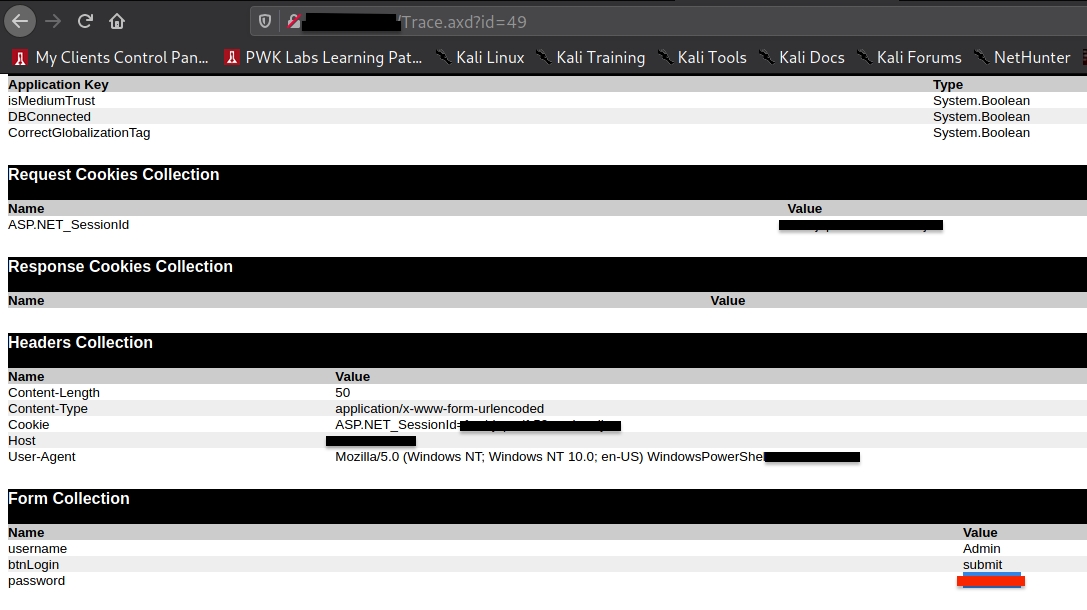IIS - Internet Information Services
Test executable file extensions:
asp
aspx
config
php
Internal IP Address disclosure
On any IIS server where you get a 302 you can try stripping the Host header and using HTTP/1.0 and inside the response the Location header could point you to the internal IP address:
nc -v domain.com 80
openssl s_client -connect domain.com:443Response disclosing the internal IP:
GET / HTTP/1.0
HTTP/1.1 302 Moved Temporarily
Cache-Control: no-cache
Pragma: no-cache
Location: https://192.168.5.237/owa/
Server: Microsoft-IIS/10.0
X-FEServer: NHEXCHANGE2016Execute .config files
You can upload .config files and use them to execute code. One way to do it is appending the code at the end of the file inside an HTML comment: Download example here
More information and techniques to exploit this vulnerability here
IIS Discovery Bruteforce
Download the list that I have created:
It was created merging the contents of the following lists:
https://raw.githubusercontent.com/danielmiessler/SecLists/master/Discovery/Web-Content/IIS.fuzz.txt http://itdrafts.blogspot.com/2013/02/aspnetclient-folder-enumeration-and.html https://github.com/digination/dirbuster-ng/blob/master/wordlists/vulns/iis.txt https://raw.githubusercontent.com/danielmiessler/SecLists/master/Discovery/Web-Content/SVNDigger/cat/Language/aspx.txt https://raw.githubusercontent.com/danielmiessler/SecLists/master/Discovery/Web-Content/SVNDigger/cat/Language/asp.txt https://raw.githubusercontent.com/xmendez/wfuzz/master/wordlist/vulns/iis.txt
Use it without adding any extension, the files that need it have it already.
Path Traversal
Leaking source code
As any .Net application, MVC applications have a web.config file, where "assemblyIdentity" XML tags identifies every binary file the application uses.
In the previous output you can references to several "assemblyIdentity". These are files that may be located inside the /bin folder. For example: /bin/WebGrease.dll.
Other files that could be found in the root directory of a .Net application are /global.asax
And /connectionstrings.config
Note: this file contains passwords!
Namespaces
In addition, .Net MVC applications are structured to define other web.config files, having the aim to include any declaration for specific namespaces for each set of viewpages, relieving developers to declare “@using” namespaces in every file.
Downloading DLLs
From a very previous response, the declaration of a custom namespace (since other namespaces are defaults) suggests that a DLL called "WebApplication1" is present in the /bin directory.
From the previous output, inside the /bin directory you will also be able to find the Dlls
System.Web.Mvc.dll
System.Web.Mvc.Ajax.dll
System.Web.Mvc.Html.dll
System.Web.Optimization.dll
System.Web.Routing.dll
Let's suppose that the previous DLL is importing a namespace called WebApplication1.Areas.Minded. an attacker can infer that other web.config files are present in the application, in guessable/default paths as /area-name/Views/, containing specific configurations that may refer to other DLL files present in the /bin folder.
Note how in the previous output you can see a new namespace called: WebApplication1.AdditionalFeatures which indicates that there is another Dll in the /bin folder called WebApplication1.AdditionalFeatures.dll
Common files
From here
HTTPAPI 2.0 404 Error
If you see an error like the following one:

It means that the server didn't receive the correct domain name inside the Host header. In order to access the web page you could take a look to the served SSL Certificate and maybe you can find the domain/subdomain name in there. If it isn't there you may need to brute force VHosts until you find the correct one.
Old IIS vulnerabilities worth looking for
Microsoft IIS tilde character “~” Vulnerability/Feature – Short File/Folder Name Disclosure
You can try to enumerate folders and files inside every discovered folder (even if it's requiring Basic Authentication) using this technique. The main limitation of this technique if the server is vulnerable is that it can only find up to the first 6 letters of the name of each file/folder and the first 3 letters of the extension of the files.
You can use https://github.com/irsdl/IIS-ShortName-Scanner to test for this vulnerability:java -jar iis_shortname_scanner.jar 2 20 http://10.13.38.11/dev/dca66d38fd916317687e1390a420c3fc/db/

Original research: https://soroush.secproject.com/downloadable/microsoft_iis_tilde_character_vulnerability_feature.pdf
You can also use metasploit: use scanner/http/iis_shortname_scanner
Basic Authentication bypass
Bypass a Baisc authentication (IIS 7.5) trying to access: /admin:$i30:$INDEX_ALLOCATION/admin.php or /admin::$INDEX_ALLOCATION/admin.php
You can try to mix this vulnerability and the last one to find new folders and bypass the authentication.
ASP.NET Trace.AXD enabled debugging
ASP.NET include a debugging mode and its file is called trace.axd.
It keeps a very detailed log of all requests made to an application over a period of time.
This information includes remote client IP's, session IDs, all request and response cookies, physical paths, source code information, and potentially even usernames and passwords.
https://www.rapid7.com/db/vulnerabilities/spider-asp-dot-net-trace-axd/

ASPXAUTH Cookie
ASPXAUTH uses the following info:
validationKey(string): hex-encoded key to use for signature validation.decryptionMethod(string): (default “AES”).decryptionIV(string): hex-encoded initialization vector (defaults to a vector of zeros).decryptionKey(string): hex-encoded key to use for decryption.
However, some people will use the default values of these parameters and will use as cookie the email of the user. Therefore, if you can find a web using the same platform that is using the ASPXAUTH cookie and you create a user with the email of the user you want to impersonate on the server under attack, you may be able to use the cookie from the second server in the first one and impersonate the user. This attacked worked in this writeup.
Last updated